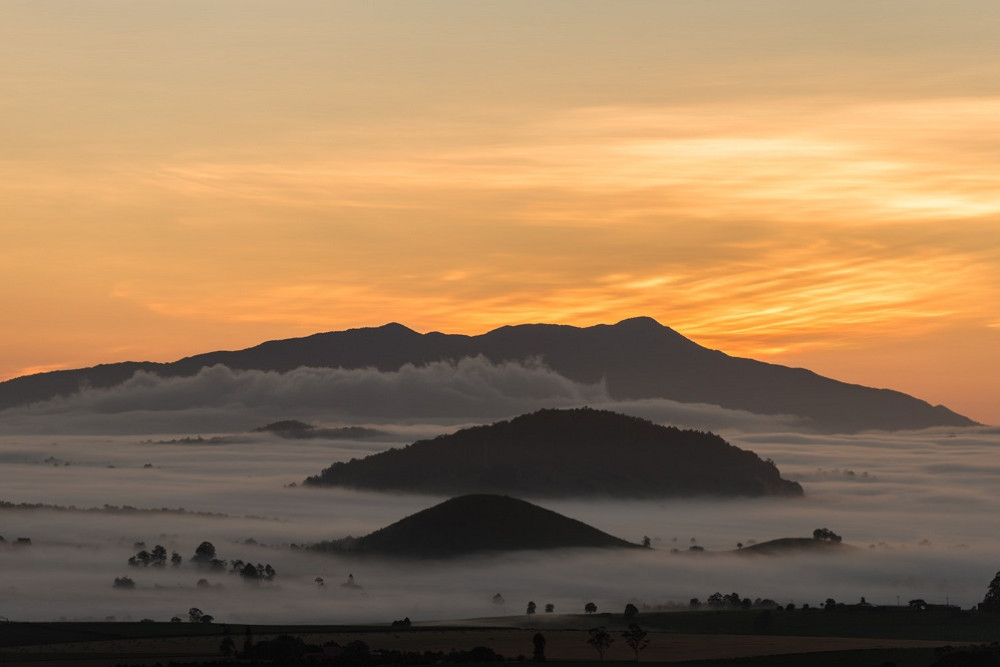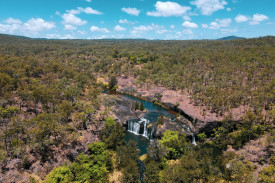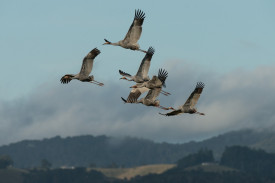General News
14 May, 2022
‘The Rainmaker’s Eden’
EVERY LANDSCAPE HAS A STORY TO TELL THE natural history of the Atherton Tablelands and their magnificent mountain is one of Australia’s most dramatic and important.

THE natural history of the Atherton Tablelands and their magnificent mountain is one of Australia’s most dramatic and important.
Pivotal to the Tablelands’ unique climate is The Rainmaker - Mount Bartle Frere, Choorichillum in the language of First Nations Ngadjon people. At 1611 metres, The Rainmaker is the highest mountain in Queensland and the summit point of the range separating the Tablelands from the intensely humid coastal lowlands and Coral Sea.
The Rainmaker created and now manages the unique highland tropical climate of the Tablelands, nurturing its immense natural and cultural diversity. Collaborating with the southeast trade winds and monsoon, The Rainmaker delivers the rain that has kept rainforests growing uninterrupted here for millions of years.
Since time immemorial Australia’s climate has fluctuated. During warm, humid times rainforests radiated from the mountain and its Tablelands. When times were dry or cold they retreated, and when the continent became hotter and drier, eucalypts and wattles, in the main, took over – except in the embrace of The Rainmaker, where its ancient rainforests still thrive.
On their arrival 50,000- 60,000 years ago, First Nations people encountered an immensely rich natural history, with many now lost giant mammals, reptiles, and birds living alongside today’s multitude of remaining species. This immensely rich fauna exerted a profound influence on peoples’ lives, helping to mould unique enduring regional cultures and leaving their mark on the landscape.
Millennia later, European settlers made use of the Tablelands’ timber and fertile soils to establish farms, which although they have impacted on native species of plants and animals have somehow managed to retain a significant level of natural diversity – avoiding the levels of local extinctions experienced in most other Australian regions.
Much of what remains is unique - rainforest so dense and complex that forests grow within forests and plants upon plants. At 60 million years old, the rainforests of The Rainmaker and Tablelands are the most ancient broadleaved rainforests on earth, where earliest flowering plants live beside some of the most highly evolved. The direct ancestors of eucalypts, she-oaks and banksias, now dominating much of the Australian landscape, still thrive here.
It’s a place where possums are green and kangaroos climb trees; where golden birds build huge structures out of twigs and decorate them with orchid flowers; where birds of paradise in iridescent plumage dance and posture on their stages; and modern-day feathered dinosaurs, nearly two metres tall, stride through the undergrowth. A place of wonder and significance.
All this flourishes in a rugged landscape where you can watch the mountain make rain and wild water cascade down rocky gorges, plunging over a thousand waterfalls. Granite of great age lies next to volcanic cones and deep crater lakes, some of which were blasted out of the earth as geologically recently as 10,000 years ago and recorded in First Nations’ oral history.
It's clear that the Tablelands is not just any place, it is a true tropical Gondwanan relict, what remains of the tropical rainforests that once covered Australia. Some of the plants that flourished then are still here and only here. Even older fossil Kauris, almost indistinguishable from those growing 60 million years ago, can be found growing on the banks of Lake Barrine today.
There is no other place like it. Because of its geography – a tableland of volcanic soils with moisture-bearing windward trades, located at a key latitude between tall mountains and the Great Dividing Range – the Tablelands have been and will remain significantly less subject to the excesses of climate change.
Once we have managed to moderate human-induced climate change, as we must, it is essential that the biodiversity of The Rainmaker and its Tablelands remains in waiting to recolonise a blasted continent. Over the past few years, the realisation has come to many that these forests could hold the master key to Australia’s natural heritage.
Despite their ancient lineage and restricted distribution, our regional rainforests and monsoon woodlands are not stagnating remnants. They’re vigorous and varied, one of the world’s greatest natural treasures and untold stories. Through their celebration in art and literature, their inestimable value must be brought to the attention of as wide an audience as possible.
The Atherton Tablelands Foundation was established to celebrate this. But it’s not just about ecology, there is a special quality of light on the Tablelands, which cannot fail to have influenced all those who were born, have worked, visited or come to live in its truly magnificent and important landscapes.
More than anyone though, younger people realise that recognition of Australia’s landscape legacy relies on equal respect for all its natural and cultural elements. They know this is vital to their future and all generations to come.
People have been associated with the natural history of The Rainmaker and its Tablelands for 50,000-60,000 years. Telling the story of the immensely diverse fauna from before First Nations people arrived up until the present day, will engage audiences across society and help the wider community to realise how deeply this amazing natural treasure can enrich the daily lives of each and every one of us.
The Foundation is developing keystone projects to bring into focus this amazing and little recognised significance, diversity, and ecological importance – especially important in this time of unprecedented climate change.
As the founding initiative of the Atherton Tablelands Foundation, the “Lost Giants of the Atherton Tablelands” project is designed to bring this story to life.




